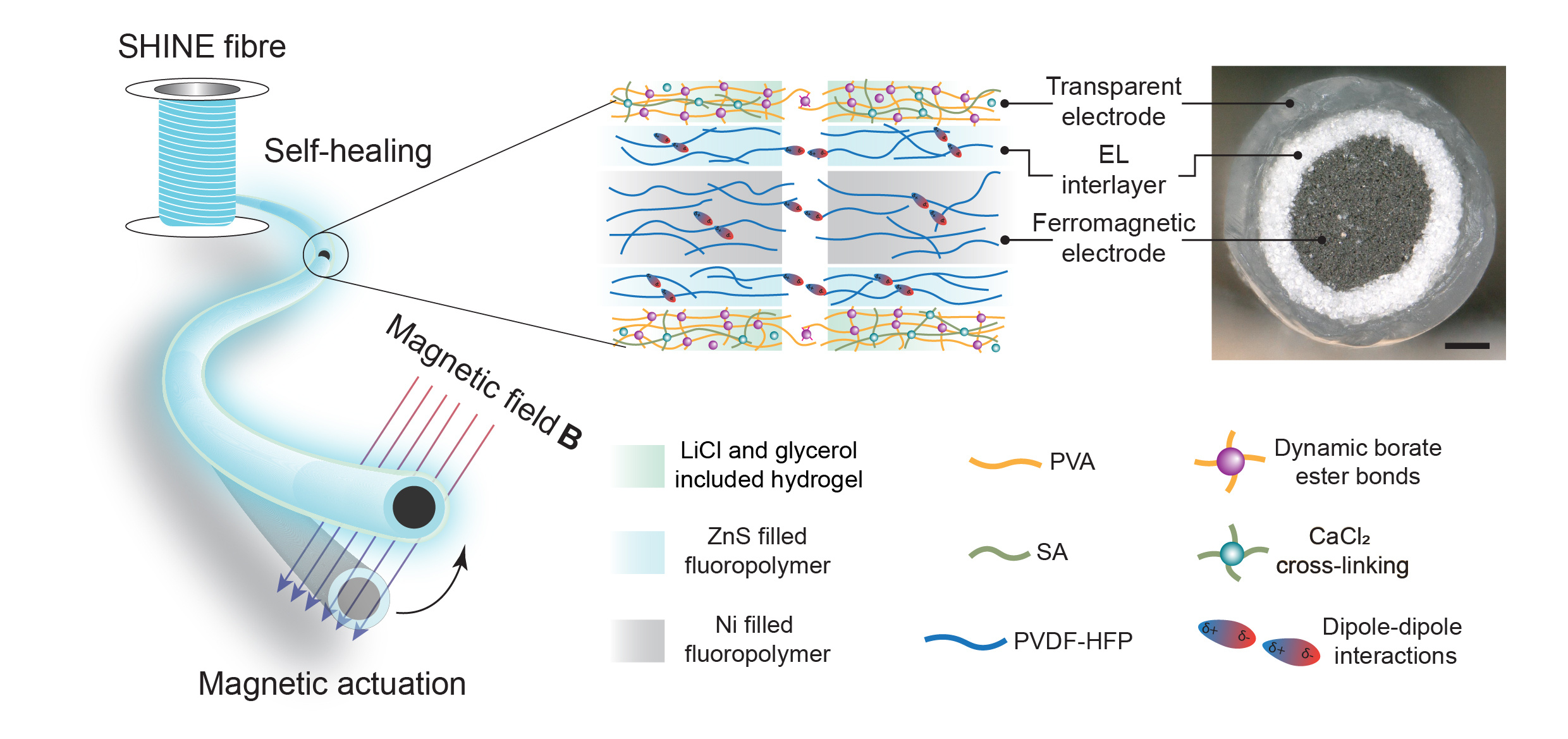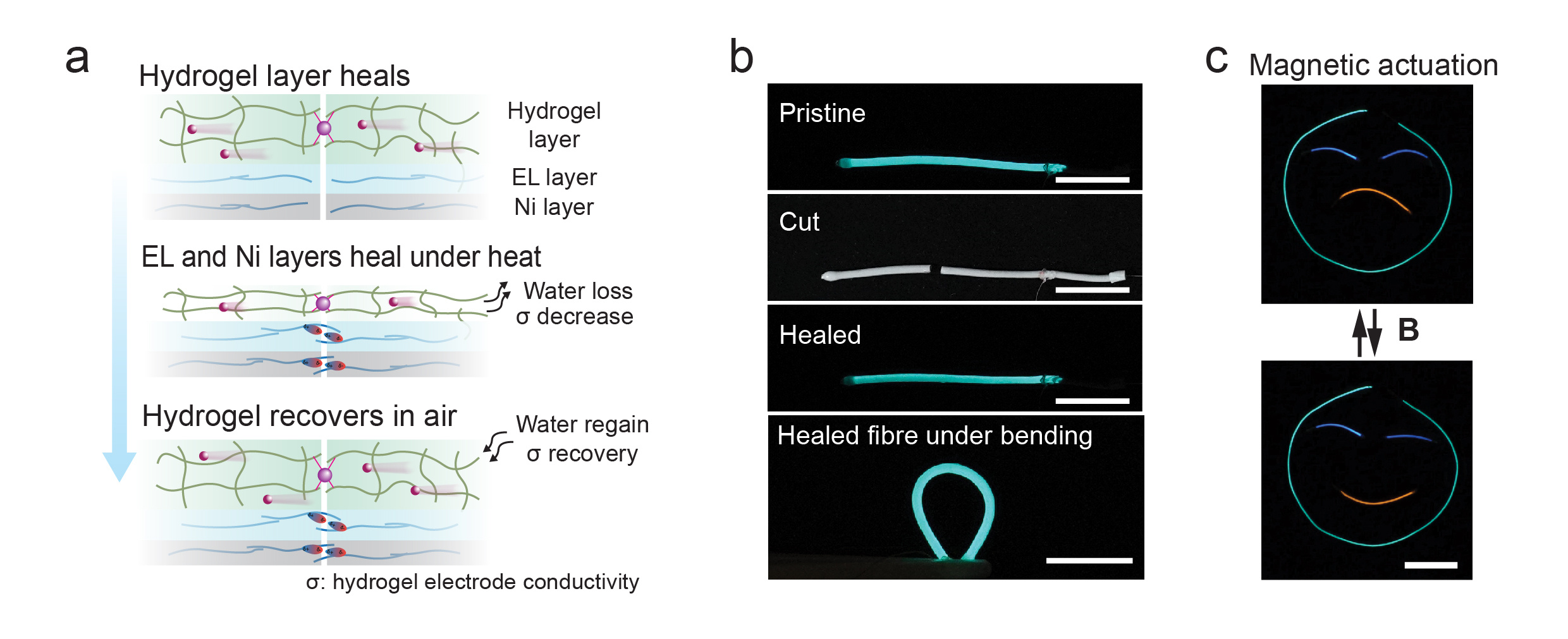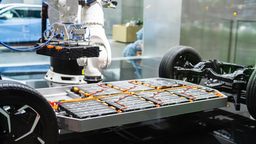Developing a class of autonomous self-healing electroluminescent magnetic fibres
Published in Sustainability

Light is the primary means of digital communications between humans and machines. Fibres enable many types of technologies from clothing to optical communications, and light-emissive optoelectronic fibres could enable new applications in smart textiles and soft machines.
Fibres are intrinsically flexible which allows for bending, twisting, and adaptation to narrow spaces. However, normal use could cause physical damage in these fibres, leading to device deterioration or failure. This suggests an opportunity for developing self-healing fibres.
Working off this idea, and building on our group’s earlier research on self-healing dielectrics that enables record light emission luminance per electric field applied in alternating current (a.c.) electroluminescent (EL) devices,1 we developed a new fibre material system that not only emits light, but also can be magnetically actuated.
In the world of self-healing EL devices, almost all of the current demonstrated devices were made of flat, large area substrates. This is likely due to the multilayer structure of the devices (top electrode, dielectric EL layer, bottom electrode, Figure 1a),2-4 which poses significant challenges in interfacial mechanics and compatibility. 
Figure 1. Schematics of typical structures of planar and fibre EL devices.
Moving towards a multilayer coaxial form factor presents even greater challenges in material compatibility. All materials used must also be autonomously self-healing. For example, the outer electrode requires self-healing as well as transparency, electrical conductivity, and the compatibility with other coaxial layers.
In designing a self-healing EL fibre, we have successfully achieved self-healing in the EL layer and the counter electrode. However, developing a self-healing transparent fibre electrode was more challenging. Typically, transparent self-healing electrodes include ionic gels and hydrogels, but ionic gels have low conductivity while ionic hydrogels will lose water over time and under heat.
Why don’t we use a hygroscopic hydrogel? Then it can absorb moisture to regain water.
Intrigued by these challenges, we sought to brainstorm new combinations of materials that could enable such a new type of light emitting “muscles”. The central idea is that our fibre is made from a hygroscopic hydrogel gelled on a high dielectric “muscle” fibre, to address the incompatibility challenges. 
Figure 2. Design of SHINE fibre with self-healing and magnetic actuation capabilities. Inset at the top right is a cross-sectional optical microscope image of a SHINE fibre. Scale bar, 200 μm.
Here, we propose a Scalable Hydrogel-clad Ionotronic Nickel-core Electroluminescent (SHINE) fibre that is the first self-healing actuatable EL fibre (Figure 2), to the best of our knowledge. Through ion-induced gelation process with ion pre-coating treatment, a hygroscopic hydrogel cladding uniformly formed on a fluoropolymer-based bilayer coaxial fibre, which addressed the processing incompatibility between hydrogel and fluoropolymer.
Furthermore, the hydrogel designed with hygroscopic components addressed the incompatibility in the self-healing conditions between hydrogel and fluoropolymer. The whole fibre was heated at 50 °C to facilitate the self-healing of the two layers in the fluoropolymer-based fibre, leading to the decrease of water and conductivity in the hydrogel electrode. However, the hydrogel electrode absorbed moisture to recover when placed under ambient conditions (Figure 3a). It allowed SHINE fibre to self-heal after being completely cut (Figure 3b) and to recover 98.6% of its pristine luminance. 
Figure 3. a Schematic of self-healing process. Water loss occurs in the hydrogel during heating the whole fibre to facilitate the self-healing of EL and Ni layers, leading to a decrease in hydrogel conductivity; however, both water content and conductivity recover when the hydrogel regains water by absorbing moisture from air. b Photos showing a lit pristine fibre, the cut fibre, and the healed fibre which light up entirely again and is bent to a bending radius of ~5mm. Scale bars, 1 cm. c An interactive display consisting of SHINE fibres with different colors, changing expressions driven by an external magnetic field (B) beneath. Scale bar, 3 cm.
SHINE fibre also serves as a soft robotic fibre with omnidirectional simultaneous actuation and electro-luminescence, and as interactive displays (Figure 3c). The ferromagnetic conducting Ni microparticles in its core layer enabled it to be actuated by external magnetic fields. SHINE fibre can navigate narrow tubular spaces and provide optical signal and feedback, with damage resilience by self-repairing the cut segments. Further, the light emission and actuation capabilities in a single device can also avoid the additional assembly challenge and energy consumption related to integrating devices of light emission and actuation.
The high dielectric fluoropolymer allowed us to achieve a record luminance of 1,068 cd∙m-2 in the EL fibre field (Figure 4a). We further manufactured a SHINE fibre of 5.5 meters in length via a reel-to-reel process. SHINE fibre remains stable with little degradation in luminance during storage for over 10 months under ambient conditions (Figure 4b), as it can continuously absorb moisture to maintain the water content. 
Figure 4. a Comparison of the luminance versus electric field of our SHINE fibre with previously reported EL fibres. b Ratio between luminance at a point in time (L) and pristine luminance (L0) of SHINE fibre stored under ambient conditions for over 10 months.
We anticipate that our approach to this multifunctional fibre will broaden the design of fibre electronics and fibre robots. It can be also applied to achieving other multilayer self-healing devices and inspire more types of intrinsically multifunctional devices in soft robots, smart displays, wearable electronics, etc.
References
1 Tan, Y. J. et al. A transparent, self-healing and high-κ dielectric for low-field-emission stretchable optoelectronics. Nat. Mater. 19, 182-188 (2020).
2 Son, D. et al. An integrated self-healable electronic skin system fabricated via dynamic reconstruction of a nanostructured conducting network. Nat. Nanotech. 13, 1057-1065 (2018).
3 Kim, Y. M., Kwon, J. H., Kim, S., Choi, U. H. & Moon, H. C. Ion-cluster-mediated ultrafast self-healable ionoconductors for reconfigurable electronics. Nat. Commun. 13, 3769 (2022).
4 Liang, G. et al. Self-healable electroluminescent devices. Light Sci. Appl. 7, 102 (2018).
Follow the Topic
-
Nature Communications

An open access, multidisciplinary journal dedicated to publishing high-quality research in all areas of the biological, health, physical, chemical and Earth sciences.
What are SDG Topics?
An introduction to Sustainable Development Goals (SDGs) Topics and their role in highlighting sustainable development research.
Continue reading announcementRelated Collections
With Collections, you can get published faster and increase your visibility.
Clinical trials 2025
Publishing Model: Open Access
Deadline: Dec 31, 2025
Women's Health
Publishing Model: Hybrid
Deadline: Ongoing




Please sign in or register for FREE
If you are a registered user on Research Communities by Springer Nature, please sign in